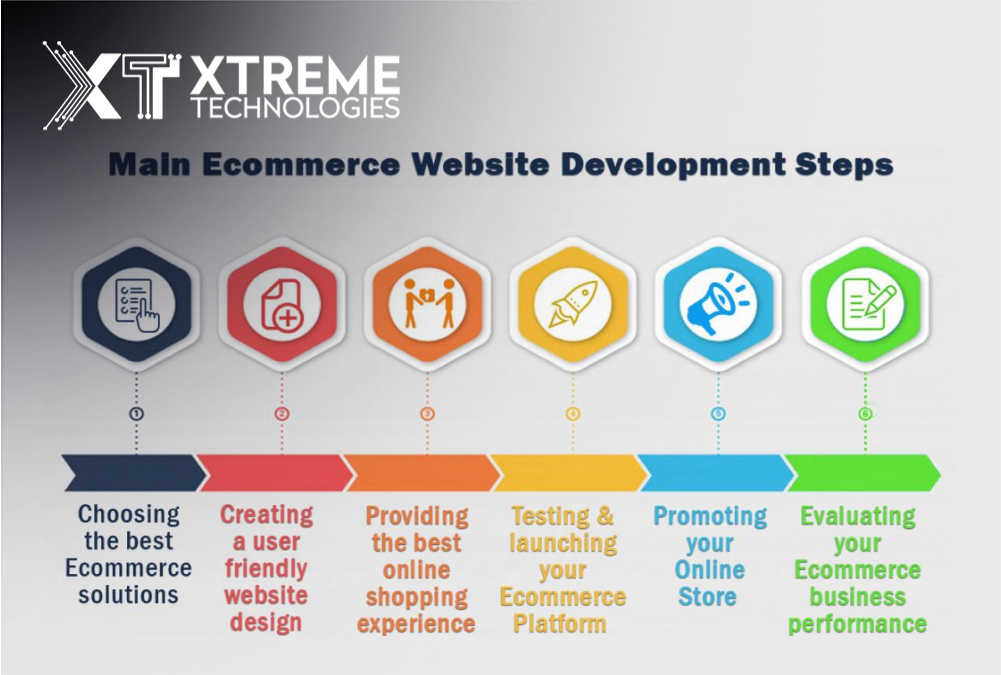
A Step-by-Step Guide to Ecommerce Website Development: Thirteen Essential and Simple Steps
All, Digital Marketing, E-commerce-business,
Published on: May 24, 2023
Contents
hide
Introduction:
In today's highly competitive digital era, it has become imperative for businesses, irrespective of their size, to establish a strong online presence. One of the most effective ways to tap into the vast potential of online sales is by developing a robust ecommerce website. However, the process of ecommerce website development demands meticulous planning, attention to detail, and flawless execution. In this article, we will delve into the thirteen simple steps involved in creating a seamless and successful ecommerce website.Define Objectives and Goals:
The initial step in ecommerce website design services is to clearly define your objectives and goals. Take the time to carefully articulate what you aim to achieve through your online store. Identify your target audience, outline your business goals, and establish key performance indicators (KPIs) that will enable you to measure the success of your ecommerce venture. Having a clear understanding of your objectives will serve as a guiding compass throughout the development process.
Conduct Thorough Market Research:
Extensive market research is a vital component of building a successful ecommerce website. By conducting comprehensive research, you can gain valuable insights into your target market, analyze your competitor's websites, and identify emerging trends in the ecommerce industry. This research will help you understand customer expectations, stay abreast of industry standards, and incorporate best practices into your website design and functionality.
Plan Website Structure and Functionality:
An effective ecommerce website requires careful planning of its structure and functionality. Create a detailed sitemap that outlines your website's various pages, categories, and subcategories. Consider the user flow and ensure intuitive navigation to facilitate a seamless browsing experience for your customers. Determine the features and functionalities required, such as shopping carts, product filters, wishlists, and customer reviews, to provide an enhanced shopping experience.Choose an Ecommerce Platform:
Selecting the right ecommerce platform is pivotal to the success of your online store. There are several popular platforms available, including WooCommerce, Shopify, Magento, and BigCommerce. Evaluate each platform based on factors such as ease of use, customization options, security features, and integration capabilities with third-party services. Choose a platform that aligns with your specific business requirements and growth aspirations.Design and User Experience:
The design and user experience (UX) of your ecommerce website play a critical role in attracting and engaging visitors. Collaborate with experienced designers to create a visually appealing interface that reflects your brand identity. Focus on intuitive navigation, compelling product displays, and streamlined checkout processes. Additionally, prioritize mobile responsiveness to ensure that your website renders well across various devices and screen sizes.Develop Compelling Content and Product Details:
Take the time to develop high-quality, informative content for your ecommerce website. Craft captivating product descriptions that highlight the unique features and benefits of your offerings. Create engaging blog posts and articles that provide valuable insights related to your industry or niche. Incorporate relevant keywords strategically to improve search engine visibility and attract organic traffic to your website.Create and Customize the Website:
Utilize your chosen ecommerce platform to build and customize your website. Take advantage of the platform's features and tools to create a visually appealing and user-friendly interface. Customize the layout, colors, and fonts to align with your brand identity. Configure plugins or extensions that enhance the functionality and user experience of your website. Ensure the website is optimized for speed, security, and SEO by implementing caching mechanisms, securing SSL certificates, and optimizing image sizes.Integrate Secure Payment Gateways and Implement Safety Measures:
Integrate reliable and secure payment gateways that offer a variety of payment options for your customers. Prioritize customer data security by implementing SSL encryption, employing robust firewalls, and conducting regular website backups. Display trust badges and security seals prominently to instill confidence in your customers and encourage secure transactions.Implement Effective Inventory Management:
Set up an efficient inventory management system that allows you to monitor product availability, track stock levels, and automate order fulfillment processes. This will ensure accurate inventory tracking, prevent overselling, and provide real-time information to your customers. Streamlining your inventory management processes will contribute to a seamless shopping experience for your customers.Thoroughly Test and Ensure Quality Assurance:
Conduct rigorous testing of your website to ensure its functionality, usability, and compatibility across different browsers and devices. Test all features, including shopping carts, payment gateways, and contact forms, to identify and fix any bugs or glitches. Perform usability tests to ensure effortless navigation and smooth transactions. Prioritize quality assurance to deliver a flawless user experience.Optimize Your Website for Search Engines:
Implement comprehensive search engine optimization (SEO) strategies to improve your website's visibility and organic rankings. Conduct thorough keyword research and optimize your website's meta tags, headings, and URLs. Create high-quality, shareable content that attracts backlinks and social media engagement. Develop a well-rounded digital marketing strategy that includes social media marketing, email marketing campaigns, and paid advertising to drive targeted traffic to your website.Promote Your Website:
Once you have successfully tested your ecommerce website, it's time to launch it and implement a comprehensive promotional strategy. Utilize various channels to promote your website, including social media platforms like Facebook, Instagram, and Twitter. Create engaging content, run targeted ad campaigns, and collaborate with influencers to reach a wider audience. Additionally, leverage email newsletters to communicate with your existing customer base and offer exclusive promotions. Implement online advertising strategies such as pay-per-click (PPC) campaigns and display ads to drive traffic to your website. Continuously monitor the performance of your promotional efforts and make necessary adjustments to optimize conversions and user engagement.Monitor, Analyze, and Enhance:
It's essential to consistently monitor and analyze the performance of your ecommerce website. Utilize web analytics tools like Google Analytics to track key metrics such as website traffic, conversion rates, and user behavior. Analyze the data to gain insights into your customers' preferences, identify areas for improvement, and make data-driven decisions. Pay attention to user feedback and reviews to understand their experience and address any issues. Regularly update and enhance your website's features, content, and design to stay ahead of the competition and provide an exceptional user experience.Read Also: Pay-Per-Click Advertising: Elaborate 14 Best PPC Ad Networks for Marketers
By diligently following these thirteen steps, you can establish a solid foundation for your ecommerce venture. From setting clear goals and conducting thorough market research to designing and developing your website, implementing secure payment gateways, optimizing for search engines, and promoting your online store, each step contributes to the overall success of your ecommerce business. Remember to continuously monitor, analyze, and enhance your website to adapt to changing market dynamics and deliver an exceptional online shopping experience. With careful planning, execution, and ongoing optimization, your ecommerce website has the potential to thrive and drive significant growth for your business in the digital realm. While ecommerce website development may not be considered easy for beginners, it becomes more manageable with experience and knowledge. Leveraging the expertise of professionals, using user-friendly ecommerce platforms, and seeking guidance from web development communities can help simplify the process. Ultimately, the complexity of ecommerce website development depends on your familiarity with web development, the scope of your project, and the resources available to you.





Recent Comments